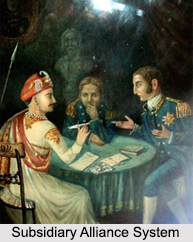 Subsidiary Alliance System was used by Lord Wellesley to bring the Indian states within the boundary of the British political power. It also was a major process that led to the building of the British Empire in India. Under this system, the ruler of the allying Indian state was compelled to accept the permanent posting of a British force within his territory and to pay a subsidy for its maintenance. It was framed by Lord Wellesley, the Governor General of India from 1798 to 1805, but was actually introduced by the French Governor General Marquis Dupleix. The Subsidiary Alliance System played a part in the expansion of the British East India Company`s dominion.
Subsidiary Alliance System was used by Lord Wellesley to bring the Indian states within the boundary of the British political power. It also was a major process that led to the building of the British Empire in India. Under this system, the ruler of the allying Indian state was compelled to accept the permanent posting of a British force within his territory and to pay a subsidy for its maintenance. It was framed by Lord Wellesley, the Governor General of India from 1798 to 1805, but was actually introduced by the French Governor General Marquis Dupleix. The Subsidiary Alliance System played a part in the expansion of the British East India Company`s dominion.
Stages of Subsidiary Alliance
There are distinct phases in the evolution of indirect rule in India until the end of the Company rule. The four stages of the company`s participation in the Indian Wars according to the policy of the Subsidiary Alliance System are as follows:
i. In the 1st stage, the Company undertook to lend its troops to a friendly native prince. For this reason the company invited the Nizam of Oudh to sign the Treaty of Subsidiary Alliance with them.
ii. In the 2nd stage, the Company used the Subsidiary Alliance diplomatically. The Company now assisted with troops only to that Indian ally who made common cause with them.
iii. In the next stage of applying Subsidiary Alliance System, the company demanded only money and not men from the native princes. The Company at the same time also declared that it would render the availability to the ally in a fixed number of troops in return of a fixed sum of money to the Company. The treaty of Hyderabad in 1798 falls under the third stage of the Subsidiary Alliance System.
iv. The final stage of the Subsidiary Alliance System was a logical step and utterly useful for the company to strengthen its political authority over the native provinces. According to this policy, the Company undertook to defend the territories of the Indian ally. The Indian allies were asked not to pay money but to surrender the territory from the revenues. According to the Company the revenues collected would be required to meet the expenses of the subsidiary forces. In this way most of the native territories surrendered their political authority to the East India Company.
Thus, Subsidiary Alliance System was nothing but one of the tactical policy of the Company in order to control the political machinery of India.
 Principles of Subsidiary Alliance System
Principles of Subsidiary Alliance System
Subsidiary Alliance System was negotiated by a several fixed terms and condition. According to the Subsidiary Alliance System, the Indian state was to surrender its external relation and had to refrain from waging any war, a bigger state was to maintain an army within its territories commanded by the British officers to preserve the public peace. Moreover the ruler or the native prince had to cede the territory with its political sovereignty for the maintenance of that force. The smaller States were also bound to pay tribute in cash to the Company. The Subsidiary Alliance System also declared that the state had to accept a British resident in the capital. This resident would be entrusted to look after the maintenance of the army and administration of the native states. The states were denied the power to employ any Europeans in its service without the prior permission of the Company. The Company had the absolute authority to control the administrative policies and interfering in the internal affairs of the state. Through the subsidiary Alliance it became the responsibility of the Company to protect the Indian state from the foreign enemy.
Impact of Subsidiary Alliance System
The Subsidiary Alliance System was one of the significant tactical policies of the British in India. It shattered the Indian states completely and established the foundation of the political authority of the British in India. The Subsidiary Alliance System deprived the Indian princes from taking any measure or forming any confederacy against the British authority in India. The posting of the Company`s army in the capital of the Indian territories enabled the English to control the strategic position in India.
Subsidiary Alliance System also helped the Company to effectively counteract any possible French moves in India. The company won the power of becoming an arbiter in the inter-state disputes. All avenues of the direct contact of the Indian states and the foreign powers were shattered. However, the immediate effect of the Subsidiary Alliance System is that the Company became the sovereign authority and the native princes acted merely as the cipher to the British. According to the terms and of the Subsidiary Alliance, the Indian princes accepting the treaty had to surrender their sovereignty. The Indian princes in this way lost their independence virtually.
The Subsidiary Alliance System supported the weak and the oppressive rulers and deprived the strong people who could put resistance to this misrule. Hence the Indian states under the policy of the Subsidiary Alliance suffered from the absence of any strong rulers who could put an end to the oppression. Moreover the native state that accepted the Subsidiary Alliance with the company courted the financial ruin. The amount of one-third money of the state revenue, which was demanded by the company, was so high that the state fell in debts. Eventually when the prince became unable to pay the tax, the territory was taken over by the Company. The policy of the Subsidiary Alliance thereby became the instrument of the Company to extend the political and the territorial authority of the British East India Company. The Subsidiary Alliance System laid the foundation of the political sovereignty of the British in India.



















